Stalin's sixth strike. Lviv-Sandomierz operation
The Red Army almost completely crushed Army Group Northern Ukraine: 32 enemy divisions (including the division of the Ukrainian SS collaborators Galichina) lost 50-70% of personnel, and 8 divisions were completely destroyed. Soviet troops completed the liberation of the entire territory of the Ukrainian SSR from the Nazis. Broken enemy troops were driven over the San and Vistula rivers. In addition, the troops of the 1 of the Ukrainian Front crossed the Vistula River and created a powerful bridgehead near the town of Sandomierz. As a result, conditions were created for an offensive in the Silesian sector.
The operation was of strategic importance - the entire German front was split in two. Now the connection between the northern and southern parts of the Wehrmacht passed through Czechoslovakia and Hungary, which made it difficult to maneuver reserves.
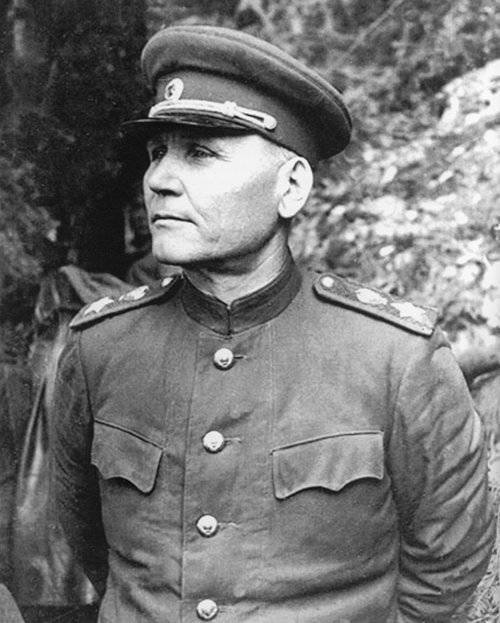
Konev Ivan Stepanovich (December 28 1897 - May 21 1973)
The situation before the operation
As a result of the successful offensive operations of the Soviet troops in the winter - spring 1944 of the year, two huge protrusions were formed on the front: one north of Pripyat, which stood out to the Soviet side, the so-called. “Belarusian balcony”, the second - to the south of Pripyat, was turned to the German side.
The Belarusian Balcony was destroyed during the Belarusian offensive operation that began on June 23. Even before the completion of Operation Bagration, it was decided to complete the liberation of Ukrainian territory and begin hostilities in South-Eastern Poland.
The southern ledge was formed during the major successes of the Soviet troops during the spring offensive in Ukraine. Here the armies of the 1 and 2 of the Ukrainian fronts penetrated deep into the German defenses. The troops of the 1 of the Ukrainian Front, commanded by I. S. Konev, after completing the winter-spring 1944 offensive operations, went over to the defensive in the second half of April. The 1944 of the Army of the front occupied the 440-kilometer sector at the turn west of Lutsk, east of Brody, west of Tarnopol, Chertkov, Kolomyia, Krasnoilsk. German troops were pressed to the Carpathians. Soviet troops covered the Army Group Center from the south, separated the enemy front, separating Army Group North Ukraine from Army Group South Ukraine. This seriously complicated the interaction, maneuver and transfer of German reserves. This ledge created favorable conditions for the offensive of the Red Army in Lviv and Bucharest.
Having suffered a crushing defeat in the spring of 1944, precisely in the southern strategic direction, the German command was expecting a Soviet offensive in the south. Given the deep penetration of the troops of the 1st Ukrainian Front in the Lvov direction, the German command was waiting for the main blow here. In the opinion of the German military-political leadership, to the north, in Belarus, one could expect only auxiliary offensive operations of the enemy. Therefore, by the beginning of summer, the bulk of the mobile, armored formations of the Wehrmacht were concentrated south of Pripyat. Here the Germans kept 18 tank divisions from the available 23 divisions on the Eastern Front. There were 1 enemy tank divisions directly in the defense sector of the 10st Ukrainian Front.
The German command sought to keep Western Ukraine at all costs, to have a springboard for a possible counterattack and a cover area for South-Eastern Poland. The southeastern region of Poland was of great economic (Silesian industrial region) and military-strategic importance.
Assessing the military-strategic situation that developed by the summer of 1944, the Supreme Command decided to conduct a series of consecutive offensive operations. The first blow was struck in Belarus, the second - in Ukraine. As a result, they planned to liberate the rest of the Byelorussian SSR, part of the Lithuanian SSR, Western Ukraine and South-Eastern Poland. For this it was necessary to crush the main forces of the German Army Group "Center" and "Northern Ukraine".
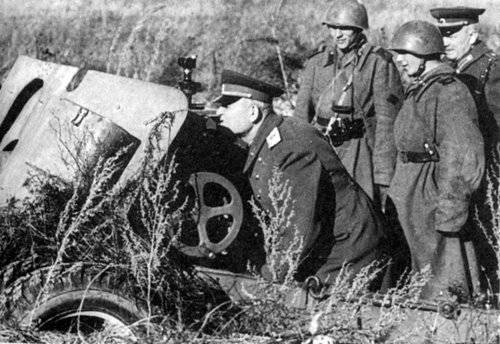
Commander 1-th Ukrainian Front I.S. Konev positions
Operation plan
At the beginning of June, Joseph Stalin invited Ivan Konev to present his ideas about the future offensive. The headquarters of the 1 of the Ukrainian Front did a great job of planning the operation. Its goal was to dissect and destroy in parts the Army Group “Northern Ukraine”, liberate Western Ukraine, and begin liberation from the occupiers of Poland.
The front command decided to deliver two powerful blows and break through the enemy defenses in two directions. The first strike was planned to be inflicted from the Lutsk area along the Sokal-Rawa-Russkaya-Yaroslav line. The second blow was delivered from the Tarnopol region (Ternopil) along the Lviv-Przemysl line. The offensive of the 1-th Ukrainian Front in two directions allowed encircling and destroying the Lviv-Brod grouping, creating a big breach in the German defense and seizing a key enemy defense point - Lviv. Army Group "Northern Ukraine" was cut into two parts, one part was planned to be thrown into the area of Polesie, the other - to the Carpathians. After that, the main forces of the front were to reach the Vistula, having the opportunity to proceed with the liberation of Poland.
The shock grouping of the front in the Rava-Russian direction included: the 3rd Guards Army, the 13th Army, the 1st Guards Tank Army, the mechanized cavalry group (the 1st Guards Cavalry Corps and the 25th Tank Corps). From the air, the northern grouping of the 1st Ukrainian Front was supported by four aviation corps of the 2nd Air Army. The shock group (14 rifle divisions, two tank, mechanized, cavalry corps, and 2 artillery breakthrough divisions) was to strike at a 12-kilometer breakthrough.
The strike grouping of the front on the Lviv (southern) direction included: 60-I and 38-I armies, 3-I Guards Tank Army, 4-I Tank Army, equestrian group (6-I Guards Corps Corps and 31-Tank Corps ). From the air, the actions of the northern strike group were supported by the five air corps of the 2 Air Force. The South Shock Group (15 rifle divisions, 4 armored, 2 mechanized, cavalry corps and 2 artillery breakthrough divisions) struck at the 14-kilometer front.
An auxiliary strike in the Galich direction was inflicted by the troops of the 1 Guards Army. The guards had to use the success of the neighboring 38 army and break through the enemy defenses, advancing on Galich and Stanislav. 1-I Guards Army was supposed to seize a bridgehead on the west bank of the Dniester in the area north of Galich. This strike ensured the advance of the southern grouping of the front from the left flank, bounding the enemy’s reserves. To accomplish this task, a strike force was formed as part of five rifle divisions and the 4 Guards Tank Corps.
The 18 Army and the left wing of the 1 Guards Army were given the task to firmly hold their lines and be ready to strike at the Stanislav direction. The 5-I Guards Army remained in reserve for the front. She, at the direction of the Supreme High Command, was transferred from the 2 of the Ukrainian Front. The 47 th infantry corps (from the 1 th Guards Army) was also withdrawn to the front reserve.
7 July front presented a plan for Operation Bet. After careful study, the Supreme Commander Stalin approved the plan of the operation. Some doubt was caused by the idea of applying two main blows to Rav-Russian and Lvov directions. However, Konev was able to convince the Stake that the decision was correct. The Supreme Command rate has made some changes to the plan of operation Tank armies and KMG were to be used not for breaking through the enemy defenses, but for developing the first success. Tank troops followed in the second echelon and were to join the battle after breaking through the enemy defenses. Horse-mechanized groups were supposed to launch an offensive on the second day of the operation, after the tank armies entered the battle. In addition, the Stavka recommended giving feasible tasks to the infantry units on the first day of the operation, when the infantry was to crack the German defenses. In the opinion of the High Command Control Command, the level of tasks assigned to rifle divisions was overstated.
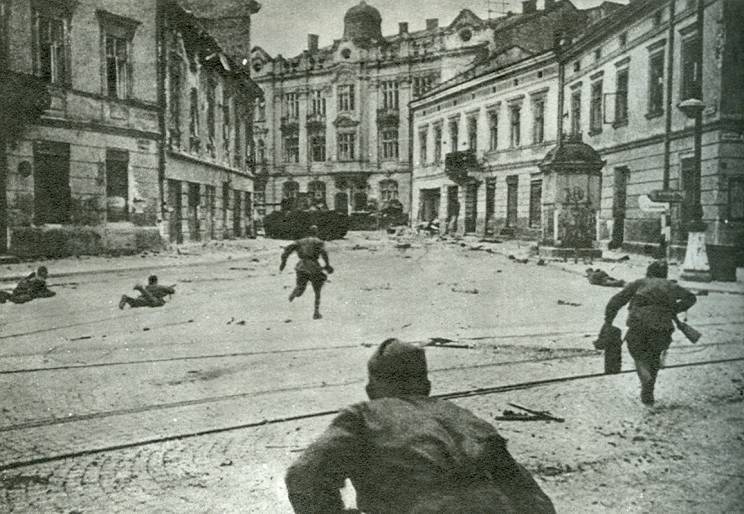
Soviet soldiers are fighting in the streets of Lviv
Forces of the parties. Soviet Union
The 1 of the Ukrainian Front included:
- 3-I Guards Army under the command of General Vasily Nikolayevich Gordov;
- 13-I army under the command of Nikolai Pavlovich Pukhov;
- 60-I army commanded by Pavel Alekseevich Kurochkin;
- 38-I army under the command of Kirill Semenovich Moskalenko;
- 1-I Guards Army under the command of Andrei Antonovich Grechko;
- 5-I Guards Army under the command of Alexei Semenovich Zhadov;
- 18-I army under the command of Evgeny Petrovich Zhuravlev;
- 1-I Guards Tank Army under the command of Mikhail Efimovich Katukov;
- 3-I Guards Tank Army of Pavel Semenovich Rybalko;
- 4-I tank army Dmitry Danilovich Lelyushenko.
The front also included two horse-mechanized groups (25 and 31 tank corps under the command of F. G. Anikushkin and V. E. Grigoriev, 1 and 6 of the Guards cavalry corps V. K. Baranova, S.V. Sokolov), and the 1 of the Czechoslovak Army Corps. From the air, the front was supported by the 2-I air army under the command of S. A. Krasovsky and the 8-I air army by V. N. Zhdanov.
The assault of the 1 of the Ukrainian Front was supported by partisan detachments. Significant partisan units were relocated to the western regions of Ukraine and further to the south-eastern regions of Poland. Before the onset of the 1-th Ukrainian Front, they struck at German communications on the Lviv-Warsaw and Rawa-Russkaya-Yaroslav lines. They destroyed several large enemy garrisons, paralyzed traffic on the roads. The German command was forced to throw three divisions against the partisans, which facilitated the advance of the Red Army.
In addition, during the operation to liberate Lviv, the uprising was raised by the Polish Craiova Army (about 7 thousand bayonets). The Polish command planned to occupy Lviv, to form the Polish administration, which would represent the Polish government before the command of the 1 of the Ukrainian Front and the Soviet government.
Already in the course of the operation (July 30), the 4-th Ukrainian Front was created. It was headed by I.Ye. Petrov. The 1-th Ukrainian Front, the 18-I army and the 1-I Guards Army were included in the front. 4-th Ukrainian Front received the task of advancing on the Carpathian direction.
Troops 1-th Ukrainian front consisted of 84 divisions (74 rifle, 6 4 cavalry and artillery divisions), 10 tank and mechanized housings (7 3 mechanized tank and housing), 4 separate tank crews, 18 separate tank and 24 shelf ACS. In total, the front had 843 thousand people (along with rears about 1,2 million), more than 16 thousand guns and mortars over 76-mm (according to other data about 14 thousand), 2,2 thousand tanks and ACS (according to other according to 1,6, thousand tanks and self-propelled guns), about 2,8 thousand combat aircraft (according to other sources of 3250 aircraft).
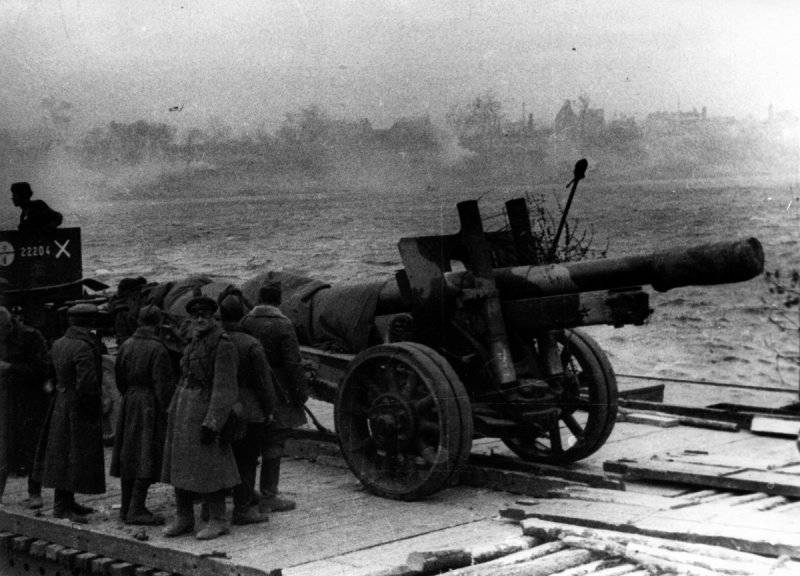
Soviet gunners forcing the Dnieper in the Lviv direction under the cover of a smoke screen
Germany
The Red Army was opposed by Army Group Northern Ukraine. It consisted of the 41 division (34 infantry, 5 tank, 1 motorized) and two infantry brigades. The German grouping consisted of more than 600 thous. Soldiers and officers (with rears more than 900 thous. People), 900 tanks and self-propelled artillery installations, 6,3 thous guns and mortars, about 700 aircraft.
Army Group led by Josef Harpe (Harpe). The army group consisted of the 4-I German Tank Army commanded by Walter Nering, the 1-I Tank Army of Erhard Raus, and the 1-I Hungarian Army. Already in the course of the battle, the Northern Ukraine’s army group included the 17 army (the newly formed army, the 17 army was destroyed in May, 1944, in the Crimea, and restored in Galicia and southern Poland), the 24 tank corps, and also a number of infantry divisions from other directions, 2 tank divisions, a division of the SS "Galicia" from the Ukrainian traitors and several other separate units. From the air, the army group was supported by the 4 air fleet.
The Germans, in anticipation of the offensive of the Red Army, launched active engineering work and prepared powerful defenses. It was especially deeply echeloned in the Lviv direction. There were prepared three defense lines to a depth of 40-50 km. The first line of defense was depth in 5-6 km. The second line of defense was located in 10-15 kilometers from the front edge. The third line of defense was along the banks of the rivers Western Bug and Rotten Lipa. A number of cities, including Lviv, were turned into strong strongholds and prepared for all-round defense.
German military builders used rugged terrain, forests, swamps and large rivers. The Western Bug, Dniester, San and Vistula were serious natural obstacles reinforced by engineering structures. In general, the terrain in the offensive zone of the Soviet troops was diverse. In the northern direction - a plain abounding in swamps; in the Lviv direction, in the center - hills, ravines with steep slopes and rivers; southern direction - mountainous terrain.
The German command had serious operational reserves. Two tank and infantry divisions were stationed south-west of Kovel, Lvov had two tank and infantry divisions, and Stanislav had two tank and two infantry divisions (they were transferred to the north). Well-developed communications allowed the enemy to make quick maneuver reserves.
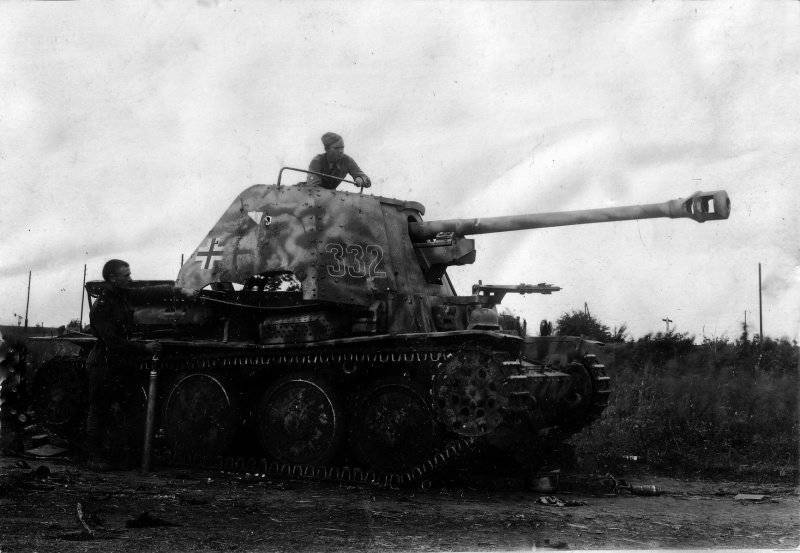
Soviet officers inspect the German middle anti-tank ACS Marder III, lined on the outskirts of Lviv.
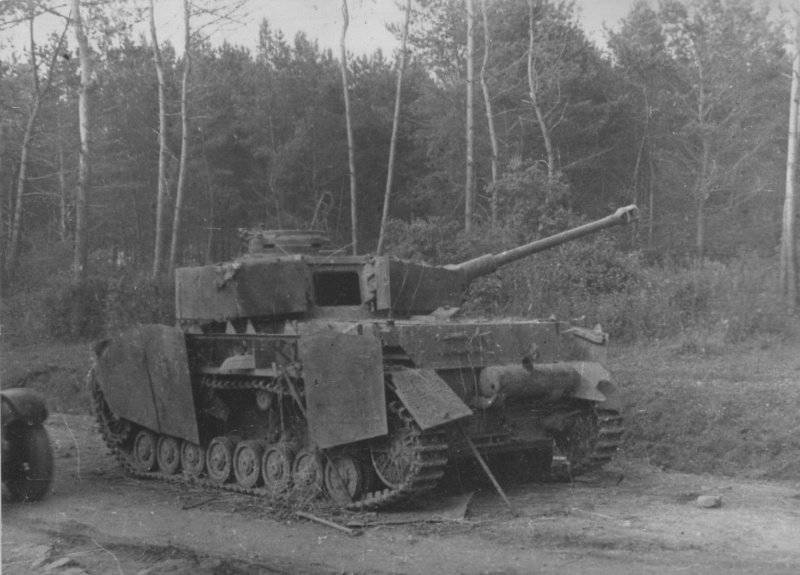
German medium tank Pz.Kpwf. IV Ausf. J, destroyed in Western Ukraine
Regrouping troops
On the eve of the operation, a significant regrouping of forces was carried out, since the main forces of the front at that time were located on the left flank. 1-th and 3-th Guards and 4-th tank armies needed to be redeployed, 38-th army to pull up. It should be noted that the Germans knew about the concentration of Soviet troops on the Stanislavsky and Lviv directions (left flank of the 1 of the Ukrainian Front). In the Lviv direction was the most powerful and dense German defense. However, the blow in the Russian-Russian direction was largely a surprise to the enemy. Here the German grouping was less strong. And the terrain was more convenient and accessible for the use of mobile, armored formations.
In order to conceal the preparation of the operation from the enemy, the Soviet command imitated concentration on the left wing of the front of two tank armies and a tank corps. For this purpose, they used false transportation of armored vehicles by rail, imitated the unloading of tank units and their march to the concentration areas before the offensive. In these areas were active radio communications. To cheat the Germans built a lot of models of tanks, cars, guns and other weapons and technology.
The real movement of troops was carried out at night, with all possible precautions and camouflage measures. It was not possible to completely deceive the enemy, but the transfer of forces of the 1 Guards Tank Army to the area south of Lutsk and the 4 Tank Army to the area of Zbarazh was kept secret.
Of the existing 84 divisions, only 28 divisions were intended for defense and action in auxiliary areas. The rest were located on the main directions. As a result, 1,1 km accounted for one Soviet division in the breakout areas. And without taking into account operational reserves. In Germans, one division defended a sector of the front in 10-15 km.
On the directions of the main attacks was concentrated to 90% of existing tanks and ACS. For the direct support of infantry units, 349 tanks and self-propelled guns were allocated. The combined-arms armies, which operated on the main axes, had 14 units of armored vehicles per 1 km of the breakthrough section. Already during the offensive, it became clear that the infantry lacked direct support tanks. Especially difficult situation was in the Lviv direction, where the enemy had the most powerful defense. To support rifle divisions, they had to send part of the forces of the 3 th Guards and 4 th armies.
As a result of the reinforced regrouping of forces, the Soviet command managed to create a huge superiority over the German forces in the breakthrough areas: in people almost 5 times (the ratio on the whole front was 1,2: 1 in favor of the Red Army), in guns and mortars - 6-7 times (on the whole front 2,6: 1), in tanks and ACS - in 3-4 times (on the entire front 2,3: 1).
Such a concentration of forces and means was necessary to break through the strong defense of the enemy. The Soviet command took into account that the German defense is well developed, deeply echeloned, has a developed system of fire, anti-tank defense and serious operational reserves. On the rest of the front, the ratio of forces was approximately equal. In some areas of the defense of the 18 Army, which had a large length of line of responsibility, the German troops even had the advantage in forces.
Soviet artillery played a major role in the breakthrough of the German defenses. As part of the front desk, do some of the troubleshooting of the objects of the city; mortar, 4 Guards mortar and 9 anti-aircraft regiments. Up to two thirds of this firepower was concentrated on the main lines of attack. At the breakthrough sites, the density of guns and mortars reached 9 units per 4 km. In the shock groups of the front formed regimental, divisional, corps and army art groups. Especially strong artillery groups created in the Lviv direction. This impressive firepower was supposed to provide a breakthrough of the enemy defenses. In general, they planned to spend 6 an hour 4 minutes on the training.
To be continued ...
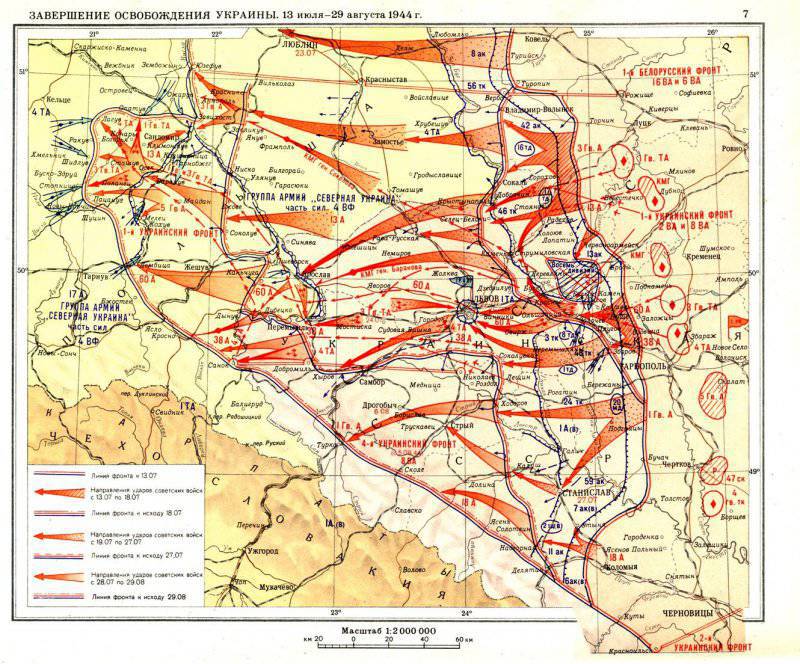
Information